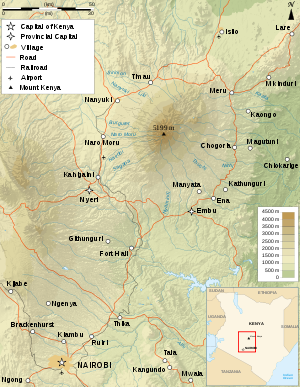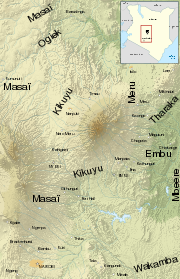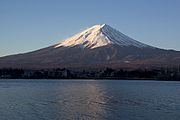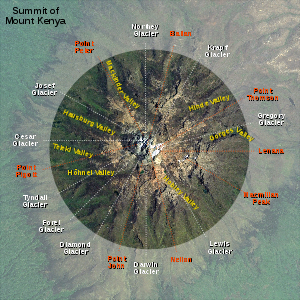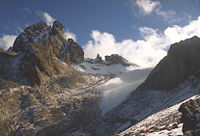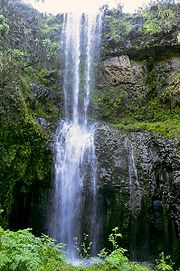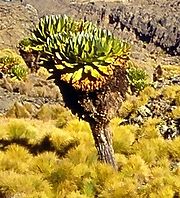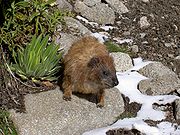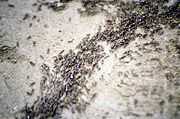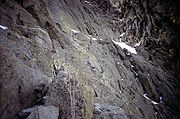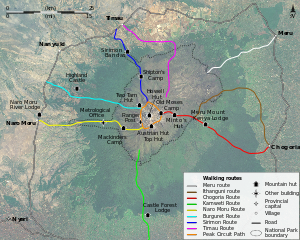
Mount Kenya
Did you know...
SOS Children volunteers helped choose articles and made other curriculum material With SOS Children you can choose to sponsor children in over a hundred countries
| Mount Kenya | |
|---|---|
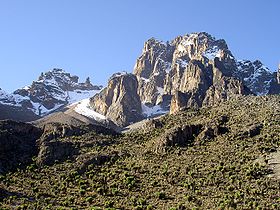 |
|
| Elevation | 5,199 m (17,057 ft) |
| Prominence | 3,825 m (12,549 ft) Ranked 32nd |
| Listing | Seven Second Summits Country high point Ultra |
| Location | |
| Location | |
| Coordinates | 0°9′00″S 37°18′00″E Coordinates: 0°9′00″S 37°18′00″E |
| Topo map | Mt Kenya by Wielochowski and Savage |
| Geology | |
| Type | Stratovolcano (extinct) |
| Last eruption | 2.6–3.1 MYA |
| Climbing | |
| First ascent | 1899 by Halford Mackinder |
| Easiest route | Rock climb |
| Mount Kenya |
|---|
| National Park |
| Natural history |
| Climate |
| Mountaineering |
| Names list |
Mount Kenya is the highest mountain in Kenya and the second-highest in Africa, after Kilimanjaro. The highest peaks of the mountain are Batian (5,199 metres (17,057 ft)), Nelion (5,188 metres (17,021 ft)) and Point Lenana (4,985 metres (16,355 ft)). Mount Kenya is located in central Kenya, just south of the equator, around (150 kilometres (93 mi)) north-northeast of the capital Nairobi. Mount Kenya is the source of the name of the Republic of Kenya.
Mount Kenya is a stratovolcano created approximately 3 million years after the opening of the East African rift. It was covered by an ice cap for thousands of years. This has resulted in very eroded slopes and numerous valleys radiating from the centre. There are currently 11 small glaciers. The forested slopes are an important source of water for much of Kenya.
There are eight vegetation bands from the base to the summit. The lower slopes are covered by different types of forest. Many species are endemic to Mount Kenya such as the lobelias, the senecios and the rock hyrax. An area of 715 square kilometres (276 sq mi) around the centre of the mountain is designated a National Park and listed as a UNESCO World Heritage Site. The park receives over 15,000 visitors per year.
Mount Kenya National Park
Mount Kenya National Park, established in 1949, protects the region surrounding the mountain. Currently the national park is within the forest reserve which encircles it. In April 1978 the area was designated a UNESCO Biosphere Reserve. The national park and the forest reserve, combined, became a UNESCO World Heritage Site in 1997.
The Government of Kenya had four reasons for creating a national park on and around Mount Kenya. These were the importance of tourism for the local and national economies, to preserve an area of great scenic beauty, to conserve the biodiversity within the park, and to preserve the water catchment for the surrounding area.
Many new routes were climbed on Batian and Nelion in the next three decades, and in October 1959 the Mountain Club of Kenya produced their first guide to Mount Kenya and Kilimanjaro. On Kenyan independence in 1963 Kisoi Munayo raised the Kenyan flag at the top of the mountain. He died in 2007 and was given a heroic funeral attended by the Kenyan president Mwai Kibaki. In the early 1970s the Mount Kenya National Park Mountain Rescue Team was formed, and by the end of the 1970s all major routes on the peaks had been climbed.
In 1997 Mount Kenya was designated a UNESCO World Heritage Site.
Local culture
The main ethnic groups living around Mount Kenya are Kĩkũyũ, Ameru, Embu and Maasai. They all see the mountain as an important aspect of their cultures.
Gĩkũyũ (aka Kikuyu)
The Gĩkũyũ live on the southern and western sides of the mountain. They are agriculturalists, and make use of the highly fertile volcanic soil on the lower slopes. The Gĩkũyũ people believe that God, Ngai or Mwene Nyaga, lived on Mount Kenya when he came down from the sky. They believe that the mountain is Ngai's throne on earth. It is the place where Gĩkũyũ, the father of the tribe, used to meet with God. Thus according to the Kikuyu records, Gĩkũyũ is the first person on Earth to ascend the mountain. The ancient Kikuyu traditional beliefs (Circumcision, Creation theory, Mountain, One God, Prophets etc) are very similar to Jewish traditions. Some believe that the Kikuyu ethnic group are descendants of the lost Jewish tribes from the days of Moses.
The Kikuyu did not believe in Kings. They preferred "parliamentary democracy" style of governance with leadership vested in a coucil of wisest and most experienced elders. These elders developed community laws, arbitrated disputes and strategized during war. This is one of the reasons Britain could not identify a single leader of the "Mau Mau". There were many.
Kikuyus used to build their houses with the doors facing the mountain. The Gĩkũyũ name for Mount Kenya is Kĩrĩ Nyaga (Kirinyaga), which literally translates to 'God's Resting Place'.
Embu
The Embu people live to the south-east of Mount Kenya, and believe that the mountain is God's home (Meru word for God is Ngai or Mwene Njeru). The mountain is sacred, and they build their houses with the doors facing towards it. The Embu people are closely related to the Ameru and Mbeere people. The Mbeere and Akamba are the settlers of the windward side of the Mountain. This is a rocky semi dry area.
Maasai
The Maasai are semi-nomadic people, who use the land to the north of the mountain to graze their cattle. They believe that their ancestors came down from the mountain at the beginning of time. The Maasai name for Mount Kenya is Ol Donyo Keri, which means 'mountain of stripes' depicting the dark shades as observed from the surrounding plains. At least one Maasai prayer refers to Mount Kenya:
God bless our children, let them be like the
olive tree of Morintat, let them grow and
Mt. Kenya, like Mt. Kilimanjaro and multiply in number.
expand, let them be like Ngong Hills like
—Collected by Francis Sakuda of Oloshoibor Peace Museum
Ameru
The Ameru occupy the East and North of the Mountain. They are generally agricultural and also keep livestock and occupy what is among the most fertile land in Kenya. The Meru God Murungu was from the skies.
Geology
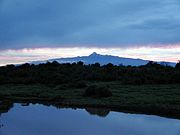
Mount Kenya is a stratovolcano that was active in the Plio-Pleistocene. The original crater was probably over 6,000 metres (19,700 ft) high; higher than Kilimanjaro. Since it became extinct there have been two major periods of glaciation, which are shown by two main rings of moraines below the glaciers. The lowest moraine is found at around 3,300 metres (10,800 ft). Today the glaciers reach no lower than 4,650 metres (15,260 ft). After studying the moraines, Gregory put forward the theory that at one time the whole summit of the mountain was covered with an ice cap, and it was this that eroded the peaks to how they are today.
The lower slopes of the mountain have never been glaciated. They are now mainly cultivated and forested. They are distinguished by steep-sided V-shaped valleys with many tributaries. Higher up the mountain, in the area that is now moorland, the valleys become U-shaped and shallower with flatter bottoms. These were created by glaciation.
When Mt Kenya was active there was some satellite activity. The north-eastern side of the mountain has many old volcanic plugs and craters. The largest of these, Ithanguni, even had its own ice cap when the main peaks were covered in ice. This can be seen by the smoothed summit of the peak. Circular hills with steep sides are also frequent in this area, which are probably the remains of small plugged vents. However, as the remaining mountain is roughly symmetrical, most of the activity must have occurred at the central plug.
The rocks that form Mt Kenya are mainly basalts, rhomb porphyrites, phonolites, kenytes and trachytes. Kenyte was first reported by Gregory in 1900 following his study of the geology of Mount Kenya.
The geology of the Mount Kenya area was first proposed to the Western Community by Joseph Thomson in 1883. He saw the mountain from the nearby Laikipia Plateau and wrote that it was an extinct volcano with the plug exposed. However, as he had only seen the mountain from a distance his description was not widely believed in Europe, particularly after 1887 when Teleki and von Höhnel ascended the mountain and described what they considered to be the crater. In 1893 Gregory's expedition reached the Lewis Glacier at 5,000 metres (16,400 ft). He confirmed that the volcano was extinct and that there were glaciers present. The first thorough survey by Europeans was not undertaken until 1966.
Peaks
The peaks of Mount Kenya are almost all from a volcanic origin. The majority of the peaks are located near the centre of the mountain. These peaks have an Alpine appearance due to their craggy nature. Typically of Alpine terrain, the highest peaks and gendarmes occur at the intersection of ridges. The central peaks only have a few mosses, lichens and small alpine plants growing in rock crevices. Further away from the central peaks, the volcanic plugs are covered in volcanic ash and soils. The vegetation growing on these peaks is typical for the vegetation band they are in.
The highest peaks are Batian (5,199 metres (17,057 ft)), Nelion (5,188 metres (17,021 ft)) and Pt Lenana (4,985 metres (16,355 ft)). Batian and Nelion are only 250 metres (270 yd) apart but separated by the Gates of Mist gap, which is equally deep. Coryndon Peak (4,960 metres (16,273 ft)) is the next highest, but unlike the previous peaks it does not form a part of the central plug.
Other peaks around the central plug include Pt Piggot (4,957 metres (16,263 ft)), Pt Dutton (4,885 metres (16,027 ft)), Pt John (4,883 metres (16,020 ft)), Pt John Minor (4,875 metres (15,994 ft)), Krapf Rognon (4,800 metres (15,748 ft)), Pt Peter (4,757 metres (15,607 ft)), Pt Slade (4,750 metres (15,584 ft)) and Midget Peak (4,700 metres (15,420 ft)). All of these have a steep pyramidal form.
Significant craggy outlying peaks include Terere (4,714 metres (15,466 ft)) and Sendeyo (4,704 metres (15,433 ft)) which form a pair of twin peaks to the north of the main plug. Together, they form a large parasitic plug. Other notable peaks include The Hat (4,639 metres (15,220 ft)), Delamere Peak, Macmillan Peak and Rotundu.
Glaciers
The glaciers on Mount Kenya are retreating rapidly. The Mountain Club of Kenya in Nairobi has photographs showing the mountain when it was first climbed in 1899, and again more recently, and the retreat of the glaciers is very evident. Descriptions of ascents of several of the peaks advise on the use of crampons, but now there is no ice to be found. There is no new snow to be found, even on the Lewis Glacier (the largest of them) in winter, so no new ice will be formed. It is predicted to be less than 30 years before there will no longer be ice on Mount Kenya. Glacial retreat and disappearance can be caused by change in temperature trends, or by change in precipitation trends.
The glacier names are (clockwise from the north):
-
- Northey, Krapf, Gregory, Lewis, Diamond, Darwin, Forel, Heim, Tyndall, Cesar, Josef.
The area of glaciers on the mountain was measured in the 1980s, and recorded as about 0.7 square kilometres (0.27 sq mi). This is far smaller than the first observations, made in the 1890s.
Periglacial landforms
Although Mount Kenya is on the equator the freezing nightly temperatures result in periglacial landforms. There is permafrost a few centimetres (inches) below the surface. Patterned ground is present at 3,400 metres (11,155 ft) to the west of Mugi Hill. These mounds grow because of the repeated freezing and thawing of the ground drawing in more water. There are blockfields present around 4,000 metres (13,123 ft) where the ground has cracked to form hexagons. Solifluction occurs when the night temperatures freeze the soil before it thaws again in the morning. This daily expansion and contraction of the soil prevents the establishment of vegetation.
Rivers
Mount Kenya is the main water catchment area for two large rivers in Kenya; the Tana, the largest river in Kenya, and the Ewaso Ng'iso North. The Mount Kenya ecosystem provides water directly for over 2 million people. The rivers on Mount Kenya have been named after the villages on the slopes of the mountain that they flow close to. The Thuchi River is the district boundary between Meru and Embu. Mount Kenya is a major water tower for the Tana river which in 1988 supplied 80% of Kenya's electricity using a series of seven hydroelectric powerstations and dams.
The density of streams is very high, especially on the lower slopes which have never been glaciated. The ice cap which used to cover the mountain during the Pliocene eroded large U-shaped valleys which tend to only have one large stream. Where the original shape of the shield volcano is still preserved, there have been millions of years for streams to erode the hillside. This area is therefore characterised by frequent deep fluvial V-shaped valleys. The gradual transition from glaciated to fluvial valley can be clearly observed.
Rivers which start on Mount Kenya are the tributaries of two large Kenyan rivers: the Tana and the Ewaso Ng'iro rivers. A lot of Mount Kenyan rivers flow into the Sagana which itself is a tributary of the Tana, which it joins at the Masinga Reservoir. The rivers in the northern part of the mountain, such as the Burguret, Naro Moro, Nanyuki, Liki, Sirimon flow into the Ewaso Ng'iro. The rivers to the south-west, such as the Keringa and Nairobi flow into the Sagana and then into the Tana. The remaining rivers to the south and east, such as the Mutonga, Nithi, Thuchi and Nyamindi, flow directly into the Tana.
Natural History
Mount Kenya has several distinct ecological zones, between the savanna surrounding the mountain to the nival zone by the glaciers. Each zone has a dominant species of vegetation. Many of the species found higher up the mountain are endemic, either to Mount Kenya or East Africa, and are highly specialised.
There are also differences within the zones, depending on the side of the mountain and aspect of the slope. The south-east is much wetter than the north, so species more dependent on moisture are able to grow. Some species, such as bamboo, are limited to certain aspects of the mountain because of the amount of moisture.
Zones
The climate of Mount Kenya changes considerably with altitude. Around the base of the mountain is fertile farmland. The tribes living around the mountain have cultivated this cool relatively moist area for centuries.
Mount Kenya is surrounded by forests. The vegetation in the forests depend on rainfall, and the species present differ greatly between the northern and southern slopes. As time has passed the trees on the edge of the forest have been logged and the farmland has encroached further up the fertile slopes of the mountain.
Above the forest is a belt of bamboo. This zone is almost continuous, but is unable to grow in the north because there is not enough rainfall. The bamboo is entirely natural, and prevents many animals from living further up the mountain. Tracks are common through the bamboo. They are made by large animals such as elephants and buffalo when they fight their ways higher. They do not spend long within the bamboo, as it is all inedible except for tender new shoots. Bamboo suppresses other vegetation, so it is uncommon to find trees or other plants here.
Above the bamboo is the timberline forest. The trees here are often smaller than the trees in the forests lower down the mountain.
When the trees can no longer grow the vegetation changes into heathland and chaparral. Heathland is found in the wetter areas, on the west side of Mount Kenya, and is dominated by giant heathers. Chaparral is found in the drier areas and grasses are more common. The ground here is often waterlogged, but bush fires are still frequent.
As the altitude increases the temperature fluctuations become extreme and the air becomes thinner and drier. This region is known as the Afro-alpine zone. The environment here is very isolated, with the only similar area nearby being the Aberdares, which are 80 kilometres (50 mi) away. Many of the species here are endemic, with adaptations to the cold and fluctuating temperatures. Typical plants here include giant groundsels (senecios) and giant lobelias.
The region where the glaciers have recently retreated from is nival zone. It is the area that plants have not yet been able to colonise. On Mount Kenya this zone is not continuous as the glaciers are no longer continuous.
Flora
The flora found on Mount Kenya varies with altitude, aspect and exposure, but very little with seasons. Lower down the mountain the air contains more moisture and oxygen, and the temperature is warm all year. As the altitude increases, the plants have to be more specialised, with adaptations to strong sunlight, little oxygen and freezing night temperatures.
Plants in the Afro-alpine zone have overcome these difficulties in several ways. One adaptation is known as the giant rosette, which is exhibited by giant senecio, lobelia and giant thistle ( Carduus). These plants have specialist ways of retaining water in the dry air, as well as preventing the water freezing overnight. They also use dead leaves or hairs to protect their buds from freezing. Another adaptation is to flower simultaneously. Plants in cold temperatures do not grow fast, so it is impossible to flower every year. By synchronising their flowering they increase their chances of pollination.
Many plants in the Afro-alpine zone of Mount Kenya tend to be large. This is an adaptation against the cold. However, nearer the nival zone the plants decrease in size again, as there are not enough resources, including warmth, to allow them to grow any larger.
Fauna
The majority of animals live lower down on the slopes of Mount Kenya. Here there is more vegetation and the climate is less extreme. Various species of monkeys, several antelopes, tree hyrax, porcupines and some larger animals such as elephant and buffalo all live in the forest. Predators found here include hyena and leopard, and occasionally lion.
No animals live permanently in the bamboo zone, although several cross it to access the higher zones of the mountain.
There are few mammals found at high altitudes on Mount Kenya. The Mount Kenya hyrax and common duiker are able to live here, and are very important to the ecosystem. Some smaller mammals, such as the groove-toothed rat, can live here by burrowing into the giant senecios and using their thick stem of dead leaves as insulation. A few larger mammals occasionally visit these altitudes. Leopard skeletons are sometimes found at altitude, and other sightings are remembered in names such as Simba Tarn (simba means lion in Swahili). However, there is not enough prey to allow these animals to live here permanently. The mole-rat Tachyoryctes rex only occurs at high altitudes on Mount Kenya.
Birds are more common than mammals in the Afro-alpine zone, with many species of sunbirds, alpine chats and starlings resident here as well as some of their predators; the auger buzzard, lammergeier and Verreaux eagle. Birds are important in this ecosystem as they pollinate many plants.
Climate
The climate of Mount Kenya has played a critical role in the development of the mountain, influencing the topography and ecology amongst other factors. It has a typical equatorial mountain climate which Hedberg described as winter every night and summer every day. Mount Kenya is home to one of the Global Atmosphere Watch's atmospheric monitoring stations.
Seasons

The year is divided into two distinct wet seasons and two distinct dry seasons which mirror the wet and dry seasons in the Kenyan lowlands. As Mount Kenya ranges in height from 1,374 metres (4,508 ft) to 5,199 metres (17,057 ft) the climate varies considerably over the mountain and has different zones of influence. The lower, south eastern slopes are the wettest as the predominant weather system comes from the Indian ocean. This leads to very dense montane forest on these slopes. High on the mountain most of the precipitation falls as snow, but the most important water source is frost. Combined, these water sources feed 11 glaciers.
The current climate on Mount Kenya is wet, but drier than it has been in the past. The temperatures span a wide range, which diminishes with altitude. In the lower alpine zone they usually do not go below 12 °C (54 °F). Snow and rain are common from March to December, but especially in the two wet seasons. The wet seasons combined account for 5/6 of the annual precipitation. The monsoon, which controls the wet and dry seasons, means that most of the year there are south-easterly winds, but during January and February the dominate wind direction is north-easterly.
Mount Kenya, like most locations in the tropics, has two wet seasons and two dry seasons as a result of the monsoon. From mid-March to June the heavy rain season, known as the long rains, brings approximately half of the annual rainfall on the mountain. This is followed by the wetter of the two dry seasons which lasts until September. October to December are the short rains when the mountain receives approximately a third of its rainfall total. Finally from December to mid-March is the dry, dry season when the mountain experiences the least rain.
Mount Kenya straddles the equator. This means during the northern hemisphere summer the sun is to the north of the mountain. The altitude and aspect of the watersheds and main peaks results in the north side of the upper mountain being in summer condition. Simultaneously, the southern side is experiencing winter conditions. Once it is the southern hemisphere summer, the situation reverses.
Daily pattern
During the dry season the mountain almost always follows the same daily weather pattern. Large daily temperature fluctuations occur which led Hedberg to exclaim winter every night and summer every day. There is variation in minimum and maximum temperatures day to day, but the standard deviation of the mean hourly pattern is small.
A typical day is clear and cool in the morning with low humidity. The mountain is in direct sunlight which causes the temperatures to rise quickly with the warmest temperatures occurring between 9 and 12am. This corresponds to a maxima in the pressure, usually around 10am. Low on the mountain, between 2,400 metres (7,874 ft) and 3,900 metres (12,795 ft), clouds begin to form over the western forest zone, due to moist air from Lake Victoria. The anabatic winds caused by warm rising air gradually bring these clouds to the summit region in the afternoon. Around 3pm there is a minimum in sunlight and a maximum in humidity causing the actual and perceived temperature to drop. At 4pm there is a minimum in the pressure. This daily cover of cloud protects the glaciers on the south-west of the mountain which would otherwise get direct sun every day, enhancing their melt. The upwelling cloud eventually reaches the dry easterly air streams and dissipates, leading to a clear sky by 5pm. There is another maxima of temperature associated with this.
Being an equatorial mountain the day light hours are constant with twelve hour days. Sunrise is about 0530 with the sun setting at 1730. Over the course of the year there is a one minute difference between the shortest and longest days. At night, the sky is usually clear with katabatic winds blowing down the valleys. Above the lower alpine zone there is usually frost every night.
Mountaineering
Climbing routes
Most of the peaks on Mount Kenya have been summited. The majority of these involve rock climbing as the easiest route, although some only require a scramble or a walk. The highest peak that can be ascended without climbing is Point Lenana, 4,985 metres (16,355 ft). The majority of the 15,000 visitors to the national park each year climb this peak. In contrast, approximately 200 people summit Nelion and 50 summit Batian, the two highest peaks.
Batian is usually climbed via the North Face Standard Route, UIAA grade IV+ (or 5.6+ YDS). It was first ascended on 31 July 1944 by Firmin and Hicks. The route is usually climbed in two days. The Normal Route is the most climbed route up Nelion. It was first climbed by Shipton and Wyn-Harris on 6 January 1929. It is possible to traverse between the two peaks, via the Gates of Mist, but this usually involves spending a night in the Howell hut on top of Nelion. There is a bolted abseil descent route off Nelion.
The satellite peaks around the mountain also provide good climbs. These can be climbed in Alpine style and vary in difficulty from a scramble to climbing at UIAA grade VI. They are useful for acclimatisation before climbing the higher peaks and as ascents in their own right.
Walking routes
There are eight walking routes up to the main peaks. Starting clockwise from the north these are the: Meru, Chogoria, Kamweti, Naro Moru, Burguret, Sirimon and Timau Routes. Of these Chogoria, Naro Moru and Sirimon and used most frequently and therefore have staffed gates. The other routes require special permission from the Kenya Wildlife Service to use.
The Chogoria route leads from Chogoria town up to the peaks circuit path. It heads through the forest to the south-east of the mountain to the moorland, with views over areas such as Ithanguni and the Giant's Billiards Table before following the Gorges Valley past the Temple and up to Simba Col below Point Lenana. The Mountain Club of Kenya claims that Ithanguni and the Giant's Billards Table offer some of the best hillwalking in Kenya.
The Naro Moru route is taken by many of the trekkers who try to reach Point Lenana. It can be ascended in only 3 days and has bunkhouses at each camp. The route starts at Naro Moru town to the west of the mountain and climbs towards Mackinder's Camp on the Peak Circuit Path. The terrain is usually good, although one section is called the Vertical Bog.
The Sirimon route approaches Mount Kenya from the north-west. The path splits on the moorlands, with the more frequently used fork following the Mackinder Valley and the quieter route traversing into the Liki North Valley. The paths rejoin at Shipton's Cave just below Shipton's Camp on the Peak Circuit Path.
The Peak Circuit Path is a path around the main peaks, with a distance of about 10 kilometres (6 mi) and height gain and loss of over 2,000 metres (6,600 ft). It can be walked in one day, but more commonly takes two or three. It can also be used to join different ascent and descent routes. The route does not require technical climbing.
Accommodation
Accommodation on Mount Kenya ranges from very basic to luxurious. The more luxurious lodges are found on the lower slopes, in and around the forest. These lodges have hotel-style accommodation, often with log fires and hot running water. Many offer guided walks and other activities such as fishing and birdwatching. The huts higher on the mountain are more basic. Most have several bunkrooms with beds, and also offer somewhere to rest, cook and eat. Some also have running water. A few huts are very basic bothies only offering a space to sleep that is sheltered from the weather. Beds in the huts can be reserved at the park gates. Camping is allowed anywhere in the National Park, but is most encouraged around the huts to limit environmental impact. It is possible for campers to use the communal spaces in the huts for no extra fee.
Etymology
The name Kenya originates from merging of Kikuyu, Embu and Kamba words Kirinyaga, Kirenyaa and Kiinyaa which means "God's resting place" in all three languages.
In the 19th Century, the German explorer, Ludwig Krapf, recorded the name as both Kenia and Kegnia believed by some to be a corruption of the Kamba version.. Others however say that this was on the contrary a very precise notation of the correct African pronounciation /ˈkɛnjə/. Nevertheless, the name was for a long time incorrectly pronounced by colonial-heritage Europeans as Kenia. The European pronounciation has been abandoned in modern times, in favour of the African version.
Names of peaks
The peaks of Mount Kenya have been given names from three different sources. Firstly, several Maasai chieftains have been commemorated, with names such as Batian, Nelion and Lenana. They commemorate Mbatian, a Maasai Laibon (Medicine Man), Nelieng, his brother, and Lenana and Sendeyo, his sons. Terere is named after another Maasai headman.
The second type of names that were given to peaks are after European climbers and explorers. Some examples of this are Shipton, Sommerfelt, Tilman, Dutton and Arthur.
The remaining names are after well-known Kenyan personalities, with the exception of John and Peter, which were named by the missionary Arthur after two disciples. There is a group of four peaks to the east of the main peaks named after European settlers; Coryndon, Grigg, Delamere and McMillan.
Books about Mount Kenya
- Facing Mount Kenya, Jomo Kenyatta, (1938); a book about Kenya and the First President's Vision for the country.
